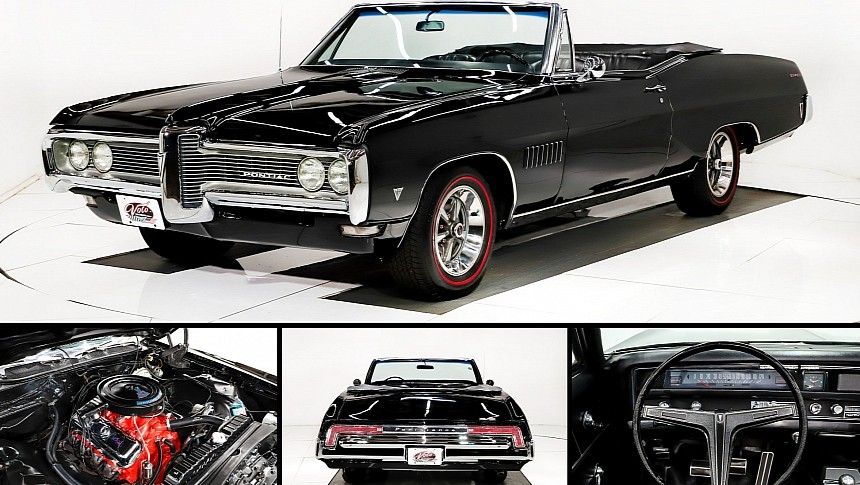Established in 1926 and discontinued in 2010, Pontiac is arguably one of America's most iconic carmakers. It's often associated with performance-oriented vehicles, but Pontiac also built massive full-size cars for decades. Famous nameplates include the Catalina, Bonneville, Grand Prix, Firebird, and, obviously, the GTO.
Unlike some American brands, Pontiac also developed several cars for the Canadian market. And because most of them were conceived before the 1965 Automotive Products Trade Agreement (APTA) that established free trade between the US and Canada, these vehicles were notably different than their home-market counterparts. And not surprisingly, they're relatively unknown to the average American.
Pontiac's venture on Canadian soil began in the 1940s, but it wasn't until 1955 that the brand rolled out a trio of full-size nameplates: the Laurentian, Pathfinder, and Strato-Chief. While these cars looked similar to US-made Pontiacs like the Catalina, they were actually a bit shorter and rode Chevrolet underpinnings. They also used Chevy drivetrains, so they were actual Pontiacs by appearance only.
While the Pathfinder was short-lived, being discontinued in 1958, the Strato-Chief remained in production until 1970, while the Laurentian soldiered on until 1981. When the Pathfinder entered the history books, GM of Canada introduced the Parisienne. Originally a sub-series within the Laurentian line, the Parisienne became a separate model in 1959.
Also a full-size similar in design to the Catalina, the Parisienne was mechanically nearly identical to the US-made Chevrolet Impala. It remained on the assembly line as Pontiac's top-of-the-line model until 1986 and spawned five generations. And because it wasn't a high seller for most model years, the Parisienne is notably rarer than most US Pontiacs.
For instance, the 1968 convertible you see here is one of only three examples built just like this. What makes it so rare? Well, it's a combination of exterior and interior finishes and the powertrain combo. For starters, it's a genuine triple-black Poncho with a Tuxedo Black exterior, black vinyl seats, and a black soft top.
Second, it's one of only 29 1968 Parisiennes fitted with the L36 V8 engine and one of only eight that also got the M20 four-speed wide-ratio manual transmission. The triple-black look and the L36/M20 combo was ordered on only three cars. This one has the GM of Canada papers to prove it, and it's probably the only surviving example.
The fact that it's been restored to a perfect finish inside and out is also a rare feat for a Canadian Poncho. And the good news doesn't end here: the L36 engine and the M20 gearbox are both numbers matching.
Unfamiliar with the GM L36 V8? Well, it's part of the Mark IV series of Chevy big-block mills which were introduced in various sizes in the 1960s. The L36 is a 427-cubic-inch (7.0-liter) lump related to the more iconic L72, L88, and L89. It cranks out 390 horsepower thanks to a four-barrel setup and was used in cars like the Chevrolet Corvette, Caprice, and Impala.
This stunning Pontiac found its way into the US recently, and it's looking for a new owner from Volo, Illinois. It's priced at $234,998, which probably makes it the most expensive Parisienne out there. Is it worth the sticker?
Pontiac's venture on Canadian soil began in the 1940s, but it wasn't until 1955 that the brand rolled out a trio of full-size nameplates: the Laurentian, Pathfinder, and Strato-Chief. While these cars looked similar to US-made Pontiacs like the Catalina, they were actually a bit shorter and rode Chevrolet underpinnings. They also used Chevy drivetrains, so they were actual Pontiacs by appearance only.
While the Pathfinder was short-lived, being discontinued in 1958, the Strato-Chief remained in production until 1970, while the Laurentian soldiered on until 1981. When the Pathfinder entered the history books, GM of Canada introduced the Parisienne. Originally a sub-series within the Laurentian line, the Parisienne became a separate model in 1959.
Also a full-size similar in design to the Catalina, the Parisienne was mechanically nearly identical to the US-made Chevrolet Impala. It remained on the assembly line as Pontiac's top-of-the-line model until 1986 and spawned five generations. And because it wasn't a high seller for most model years, the Parisienne is notably rarer than most US Pontiacs.
For instance, the 1968 convertible you see here is one of only three examples built just like this. What makes it so rare? Well, it's a combination of exterior and interior finishes and the powertrain combo. For starters, it's a genuine triple-black Poncho with a Tuxedo Black exterior, black vinyl seats, and a black soft top.
Second, it's one of only 29 1968 Parisiennes fitted with the L36 V8 engine and one of only eight that also got the M20 four-speed wide-ratio manual transmission. The triple-black look and the L36/M20 combo was ordered on only three cars. This one has the GM of Canada papers to prove it, and it's probably the only surviving example.
The fact that it's been restored to a perfect finish inside and out is also a rare feat for a Canadian Poncho. And the good news doesn't end here: the L36 engine and the M20 gearbox are both numbers matching.
Unfamiliar with the GM L36 V8? Well, it's part of the Mark IV series of Chevy big-block mills which were introduced in various sizes in the 1960s. The L36 is a 427-cubic-inch (7.0-liter) lump related to the more iconic L72, L88, and L89. It cranks out 390 horsepower thanks to a four-barrel setup and was used in cars like the Chevrolet Corvette, Caprice, and Impala.
This stunning Pontiac found its way into the US recently, and it's looking for a new owner from Volo, Illinois. It's priced at $234,998, which probably makes it the most expensive Parisienne out there. Is it worth the sticker?














